AMD Radeon R9 285 Review: Feat. Sapphire R9 285 Dual-X OC
by Ryan Smith on September 10, 2014 2:00 PM ESTCompute
Jumping into compute, our expectations regarding compute performance are going to be a mixed bag. On the one hand as part of the newer GCN 1.2 architecture AMD has been doing some tweaking under the hood, but on the other hand the most important aspects of the architecture – the memory model and thread execution – are not fundamentally different from the GCN 1.0 R9 280. As a result we’re not necessarily expecting to find any performance leaps here but there is the possibility that we will find some along the way.
As always we’ll start with LuxMark2.0, the official benchmark of SmallLuxGPU 2.0. SmallLuxGPU is an OpenCL accelerated ray tracer that is part of the larger LuxRender suite. Ray tracing has become a stronghold for GPUs in recent years as ray tracing maps well to GPU pipelines, allowing artists to render scenes much more quickly than with CPUs alone.
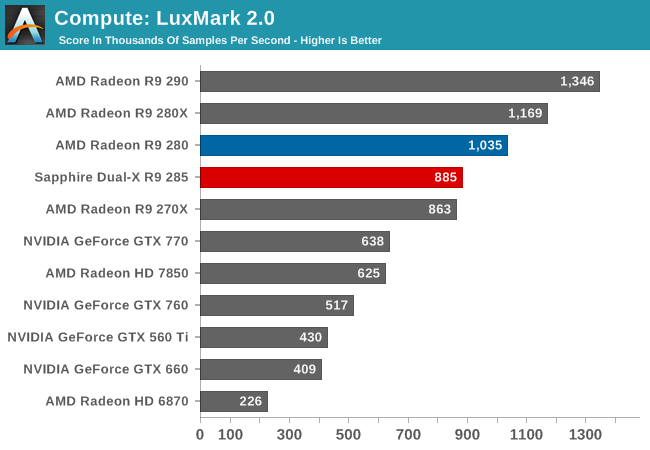
Right off the bat we find an unexpected regression in performance with LuxMark. All things considered we would expect the R9 285 to score similarly to the R9 280 given their nearly identical theoretical FP32 throughput, similar to what we’ve seen in our gaming benchmarks. Instead we have the R9 285 trailing its predecessor by 15%, and coming very close to tying the otherwise much slower R9 270X. Given that this is a new architecture there are a few possibilities here including a lack of OpenCL driver optimizations on AMD’s part, though we can’t entirely rule out bandwidth either since ray tracing can burn up bandwidth at times. Tonga is after all first and foremost a graphics product, and AMD’s memory bandwidth saving compression technology is similarly designed for graphics and not compute, meaning the R9 285 doesn’t have much to make up for the loss of bandwidth in compute tasks versus the R9 280.
In any case, even with R9 285 lagging the R9 280, it’s otherwise a strong showing for AMD. AMD cards overall perform very well on this benchmark compared to NVIDIA’s offerings, so the R9 285 has no trouble shooting well past the GTX 760.
Our 2nd compute benchmark is Sony Vegas Pro 12, an OpenGL and OpenCL video editing and authoring package. Vegas can use GPUs in a few different ways, the primary uses being to accelerate the video effects and compositing process itself, and in the video encoding step. With video encoding being increasingly offloaded to dedicated DSPs these days we’re focusing on the editing and compositing process, rendering to a low CPU overhead format (XDCAM EX). This specific test comes from Sony, and measures how long it takes to render a video.
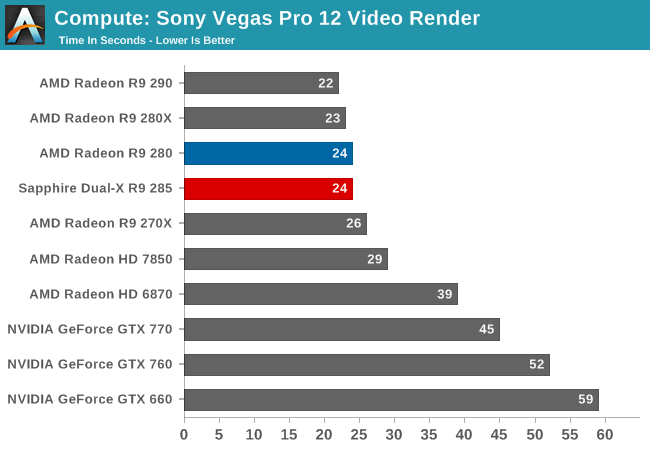
Unlike LuxMark, we aren’t seeing a performance gain nor a regression here. The R9 285 is every bit as fast as the R9 280. Meanwhile as has consistently been the case in this benchmark, all of AMD’s cards are well ahead of our NVIDIA cards.
Our 3rd benchmark set comes from CLBenchmark 1.1. CLBenchmark contains a number of subtests; for our standard benchmark suite we focus on the most practical of them, the computer vision test and the fluid simulation test. The former is a useful proxy for computer imaging tasks where systems are required to parse images and identify features (e.g. humans), while fluid simulations are common in professional graphics work and games alike.
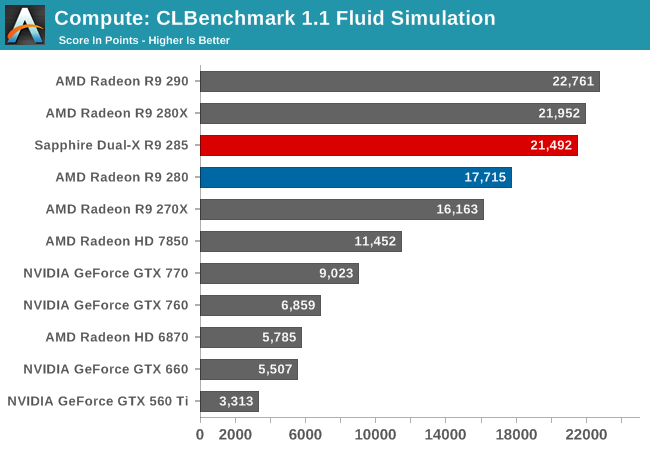
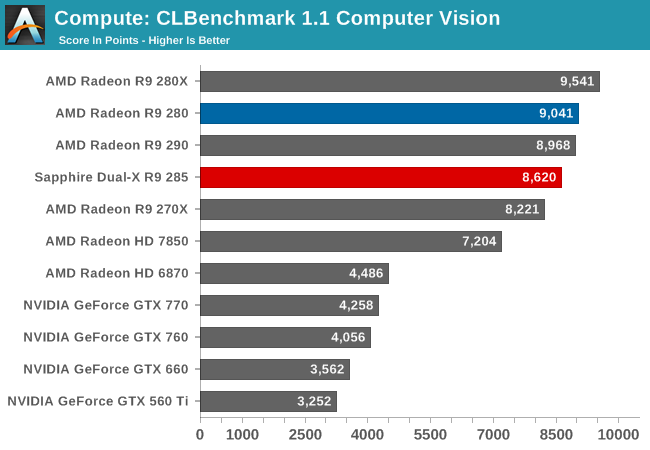
Depending on which subtest we’re looking at, the R9 285 either outperforms or trails the R9 280. The fluid simulation subtest finds the R9 285 performing just shy of the more powerful R9 280X, while the R9 285 comes up short of the R9 280 in computer vision. Computer vision is the more bandwidth sensitive benchmark of the two, so it follows that it’s the benchmark more likely to be influenced by the loss of raw memory bandwidth. Otherwise the R9 285’s strong showing in the fluid simulation is unexpected, and given what we know we’re at a bit of a loss to explain it.
Looking at the broader picture, this is yet another test where AMD’s cards do well against NVIDIA’s non-compute cards. Overall the R9 285 is 2-3x faster than the GTX 760 here.
Moving on, our fourth compute benchmark is FAHBench, the official Folding @ Home benchmark. Folding @ Home is the popular Stanford-backed research and distributed computing initiative that has work distributed to millions of volunteer computers over the internet, each of which is responsible for a tiny slice of a protein folding simulation. FAHBench can test both single precision and double precision floating point performance, with single precision being the most useful metric for most consumer cards due to their low double precision performance. Each precision has two modes, explicit and implicit, the difference being whether water atoms are included in the simulation, which adds quite a bit of work and overhead. This is another OpenCL test, utilizing the OpenCL path for FAHCore 17.
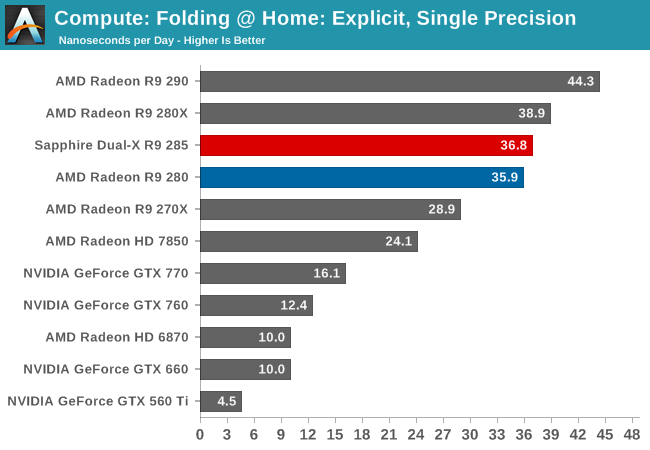
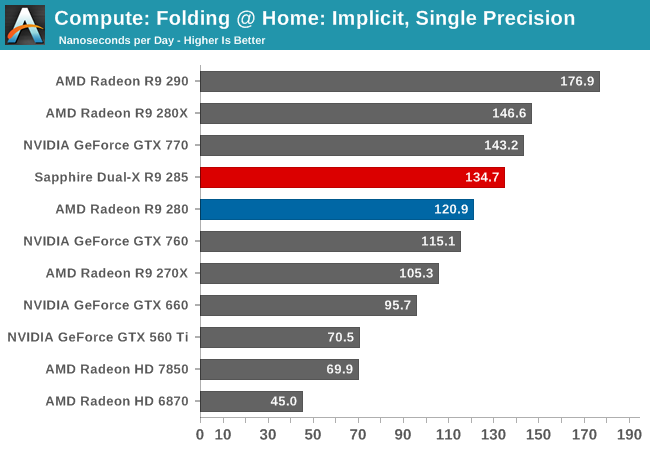
When it comes to single precision the R9 285 edges out the R9 280, though not significantly so. R9 285 still seemingly benefits from some of the GCN 1.2 architectural optimizations, but not to the same extent we’ve seen in other benchmarks.
Overall AMD’s GCN cards are a strong performer in this benchmark and the R9 285 is no exception. GTX 760 trails R9 285 when it comes to implicit single precision, and is blown away in the explicit single precision benchmark.

Meanwhile for double precision the R9 285 falls well behind the R9 280. Since Tonga is not designed to pull double-duty as a graphics and high performance compute GPU like Tahiti was, Tonga is configured for 1/16 rate double precision performance, 1/4 the rate of the more powerful Tahiti. As a result it can never keep up with the R9 280 in a double precision workload. Consequently AMD and the R9 285 still have a lead in F@H with double precision, but not to the degree we’ve seen elsewhere. The R9 285 is only about 30% faster than the GTX 760 here.
Wrapping things up, our final compute benchmark is an in-house project developed by our very own Dr. Ian Cutress. SystemCompute is our first C++ AMP benchmark, utilizing Microsoft’s simple C++ extensions to allow the easy use of GPU computing in C++ programs. SystemCompute in turn is a collection of benchmarks for several different fundamental compute algorithms, with the final score represented in points. DirectCompute is the compute backend for C++ AMP on Windows, so this forms our other DirectCompute test.
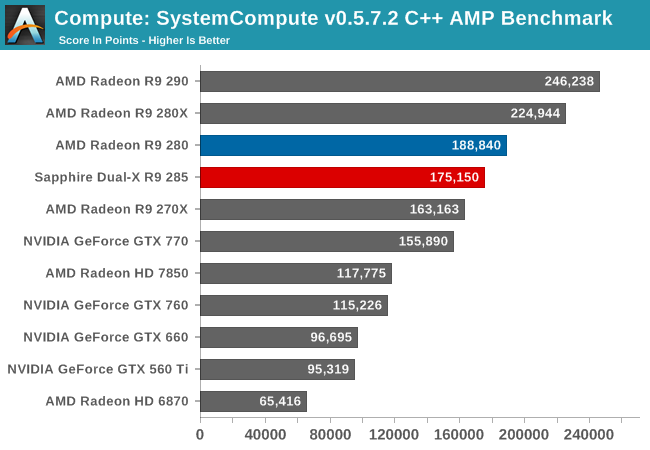
SystemCompute exposes another case where the R9 285 comes up short compared to the R9 280, though only slightly. AMD’s latest card can deliver 93% of the performance of an R9 280, and most likely it’s suffering just a bit from the reduction in memory bandwidth. Otherwise it’s still more than 50% ahead of the GTX 760 and still comfortably ahead of the more powerful GTX 770.










86 Comments
View All Comments
chizow - Thursday, September 11, 2014 - link
No issues with Boost once you slap a third party cooler and blow away rated TDP, sure :DBut just as I said, AMD's rated specs were bogus, in reality we see that:
1) the 285 is actually slower than the 280 it replaces, even in highly overclocked factory configurations (original point about theoretical performance, debunked)
2) the TDP advantages of the 285 go away, at 190W target TDP AMD trades performance for efficiency, just as I stated. Increasing performance through better cooling results in higher TDP, lower efficiency, to the point it is negligible compared to the 280.
Its obvious AMD wanted the 285 to look good on paper, saying hey look, its only 190W TDP, when in actual shipping configurations (which also make it look better due to factory OCs and 3rd party coolers), it draws power closer to the 250W 280 and barely matches its performance levels.
In the end one has to wonder why AMD bothered. Sure its cheaper for them to make, but this part is a downgrade for anyone who bought a Tahiti-based card in the last 3 years (yes, its nearly 3 years old already!).
bwat47 - Thursday, September 11, 2014 - link
I think the main reason for this card, was to bring things up to par when it comes to features. the 280 (and 280x), were rebadged older high end cards (7950, 7970), and whole these offered great value when it came to raw performance, they are lacking features that the rest of the 200 series will support, such as freesync and trueaudio, and this feature discrepancy was confusing to customers. It makes sense to introduce a new card that brings things up to par when it comes to features. I bet they will release a 285x to replace the 280x as well.chizow - Thursday, September 11, 2014 - link
Marginal features alone aren't enough to justify this card's cost, especially in the case of FreeSync which still isn't out of proof-of-concept phase, and TrueAudio, which is unofficially vaporware status.If AMD released this card last year at Hawaii/Bonaire's launch at this price point OR released it nearly 12 months late now at a *REDUCED* price point, it would make more sense. But releasing it now at a significant premium (+20%, the 280 is selling for $220, the 285 for $260) compared to the nearly 3 year old ASIC it struggles to match makes no sense. There is no progress there, and I think the market will agree there.
If it isn't obvious now that this card can't compete in the market, it will become painfully obvious when Nvidia launches their new high-end Maxwell parts as expected next month. The 980 and 970 will drive down the price on the 780, 290/X and 770, but the real 285 killer will be the 960 which will most likely be priced in this $250-300 range while offering better than 770/280X performance.
Alexvrb - Thursday, September 11, 2014 - link
You just can't admit to being wrong. It maintains boost fine - end of story. That's what I disagreed with you on in the first place. No boost issues - the 290 series had thermal problems. Slapping a different cooler doesn't raise TDP, it just removes obstacles towards reaching that TDP. With an inadequate cooler, you're getting temp-throttled before you ever reach rated TDP. Ask Ryan, he'll set you straight.On top of this, depending on which model 285 you test, some of them eat significantly less power than an equivalent 280. Not all board partners did an equal job. Look at different reviews of different models and you'll see different results. Also, performance is better than I figured it would be, and in most cases it is slightly faster than 280. Which again, I never figured would happen and never claimed.
chizow - Friday, September 12, 2014 - link
Who cares what you disagreed with? The point you took issue was a corollary to the point I was making, which turned out to be true about the theoreticals being misstated and inaccurate when basing any conclusion about the 285 being faster than the 280.As we have seen:
1) The 285 barely reaches parity but in doing so, it requires a significant overclock which forces it to blow past its rated 190W TDP and actually draws closer to the 250W TDP of the 280.
2) It requires a 3rd party cooler similar to the one that was also necessary in keeping the 290/X temps in check in order to achieve its Boost clocks.
As for Ryan setting me straight, lmao, again, his temp tests and subtext already prove me to be correct:
"Note that even under FurMark, our worst case (and generally unrealistic) test, the card only falls by less than 20Mhz to 900MHz sustained."
So it does indeed throttle down to 900MHz even with the cap taken off its 190W rated TDP and a more efficient cooler. *IF* it was limited to a 190W hard TDP target *OR* it was forced to use the stock reference cooler, it is highly likely it would indeed have problems maintaining its Boost, just as I stated. AMD's reference specs trade performance for efficiency, once performance is increased that efficiency is reduced and its TDP increases.
Alexvrb - Friday, September 12, 2014 - link
Look, I get it, you're an Nvidia fanboy. But at least you admitted you were wrong, in your own way, finally. It sustains boost fine. Furmark makes a lot of cards throttle - including Maxwell! Whoops! Should we start saying that Maxwell can't hold boost because it throttles in Furmark? No, because that would be idiotic. I think Maxwell is a great design.However, so is Tonga. Read THG's review of the 285. Not only does it slightly edge out the 280 on average performance, but it uses substantially less power. Like, 40W less. I'm not sure what's Sapphire (the card reviewed here) is doing wrong exactly - the Gigabyte Windforce OC is fairly miserly and has similar clocks.
chizow - Saturday, September 13, 2014 - link
LOL Nvidia fanboy, that's rich coming from the Captain of the AMD Turd-polishing Patrol. :DI didn't admit I was wrong, because my statement to any non-idiot was never dependent on maintaining Boost in the first place, but I am glad to see not only is 285 generally slower than the 280 without significant overclocks, it still has trouble maintaining Boost despite higher TDP than the rated 190W and a better than reference cooler.
You could certainly say Maxwell doesn't hold boost because it throttles in Furmark, but that would prove once and for all you really have no clue what you are talking about since every Nvidia card they introduced since they invented Boost has no problems whatsoever hitting their rated Boost speeds even with the stock reference blower designs. The difference of course, is that Nvidia takes a conservative approach to their Boost ratings that they know all their cards can hit under all conditions, unlike AMD which takes the "good luck/cherry picked" approach (see: R290/290X launch debacle).
And finally about other reviews lol, for every review that says the 285 is better than the 280 in performance and power consumption, there is at least 1 more that echo the sentiments of this one. The 285 barely reaches parity and doesn't consume meaningfully less power in doing so. But keep polishing that turd! This is an ASIC only a true AMD fanboy could love some 3 years after the launch of the chip it is set to replace.
chizow - Saturday, September 13, 2014 - link
Oh and just to prove I can admit when I am wrong, you are right, Maxwell did throttle and fail to meet its Boost speeds for Furmark, but these are clearly artificially imposed driver limitations as Maxwell showed it can easily OC to 1300MHz and beyond:http://www.anandtech.com/show/7764/the-nvidia-gefo...
http://www.anandtech.com/show/7854/nvidia-geforce-...
Regardless, any comparisons of this chip to Maxwell are laughable, Maxwell introduced same performance at nearly 50% reduction in TDP or inversely, nearly double the performance at the same TDP all at a significantly reduced price point on the same process node.
What does Tonga bring us? 95-105% of R9 280's performance at 90% TDP and 120% of the price almost 3 years later? Who would be happy with this level of progress?
Nvidia is set to introduce their performance midrange GM104-based cards next week, do you think ANYONE is going to draw parellels between those cards and Tonga? We already know what Maxwell is capable of and it set the bar extremely high, so if GTX 970 and 980 come anywhere close to those increases in performance and efficiency, this part is going to look even worst than it does now.
Alexvrb - Saturday, September 13, 2014 - link
You were wrong about it being unable to hold boost, you claimed that GCN 1.1 can't hold boost despite clear evidence to the contrary. Silly. Then you were wrong about Maxwell and Furmark - though you kind of admitted you were wrong.Regarding that being a "driver limitation" you can clock a GPU to the moon, and it's fine until it gets a heavy load. However most users won't even know they're being throttled. I had this same discussion YEARS ago with a Pentium 4 guy. You can overclock all you want - when you load it up heavy, it's a whole new game. In that case the user never noticed until I showed him his real clocks while running a game.
Tonga averages a few % higher performance, dumps less heat into your case, and uses less power. Aside from this Sapphire Dual X, most 285 cards seem to use quite a bit less power, run cool and quiet. With all that being said, I think the 280 and 290 series carry a much better value in AMD's lineup. I'm certainly not a fanboy, you're much closer to claiming that title. I've actually used mostly Nvidia cards over the years. I've also used graphics from 3dfx, PowerVR, and various integrated solutions. My favorite cards over the years were a trusty Kyro II and a GeForce 3 vanilla, which was passively cooled until I got ahold of it. Ah those were the days.
chizow - Monday, September 15, 2014 - link
No, I said being a GCN 1.1 part meant it was *more likely* to not meet its Boost targets, thus overstating its theoretical performance relative to the 280. And based on the GCN 1.1 parts we had already seen, this is true, it was MORE LIKELY to not hit its Boost targets due to AMD's ambiguous and non-guaranteed Boost speeds. None of this disproved my original point that the 285's theoreticals were best-case and the 280's were worst-case and as these reviews have shown, the 280 would be faster than the 285 in stock configurations. It took an overclocked part with 3rd party cooling and higher TDP (closer to the 280) for it to reach relative parity with the 280.Tonga BARELY uses any less power and in some cases, uses more, is on par with the part it replaces, and costs MORE than the predecessor part it replaces. What do you think would happen if Nvidia tried to do the same later this week with their new Maxwell parts? It would be a complete and utter disaster.
Stop trying to put lipstick on a pig, if you are indeed as unbiased as you say you are you can admit there is almost no progress at all with this part and it simply isn't worth defending. Yes I favor Nvidia parts but I have used a variety in the past as well including a few highly touted ATI/AMD parts like the 9700pro and 5850. I actually favored 3dfx for a long time until they became uncompetitive and eventually bankrupt, but now I prefer Nvidia because much of their enthusiast/gamer spirit lives on and it shows in their products.